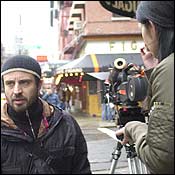
Flannery O’Connor, down among her peacocks and stigmata, once observed: “Everywhere I go I’m asked if I think the universities stifle writers. My opinion is that they don’t stifle enough of them.” Some of us feel the same way about New York University’s Film School. You hear a lot about such graduates as Martin Scorsese, Spike Lee, Amy Heckerling, and Oliver Stone. And, sure enough, all four show up in the first half-hour of Film School (Fridays, starting September 10; 10:30 to 11 p.m.; IFC). But where were they when you really needed them, when you were stuck, for reasons of consanguinity or occupational hazard, sitting through a long night of dreamy dissolves in a bomb shelter full of bipolar neophytes?
Film School is a jailbait version of Project Greenlight. From a class of 36 filmmaking wannabes, all of whom paid a $30,000 tuition fee, executive producer Nanette Burstein selects four to follow for ten weeks while they raise money, hire actors, and shoot and edit the ten-minute “calling card” by which an adult world will decide if they have a career. About Alrick, Barbara, Leah, and Vincenzo, we get backstories (the origin myths of anger and neediness) and meltdowns (anything that could go wrong does so more than once). Although Film School is absorbing, you may care more about the students than their films. A blog would have been easier on everyone.
Immediately after Indian Point: Imagining the Unimaginable (Thursday, September 9; 8 to 8:45 p.m.; HBO), a scary visit to a nuclear power plant 35 miles north of Manhattan, we’re asked to stay put for Chernobyl Heart (8:45 to 9:30 p.m.), which takes us back to the horrific site of the 1986 meltdown and then to Belarus, where thousands of babies have been born with complex heart conditions. Instead of wishful thinking, dreadful prognosis—and first-rate television.